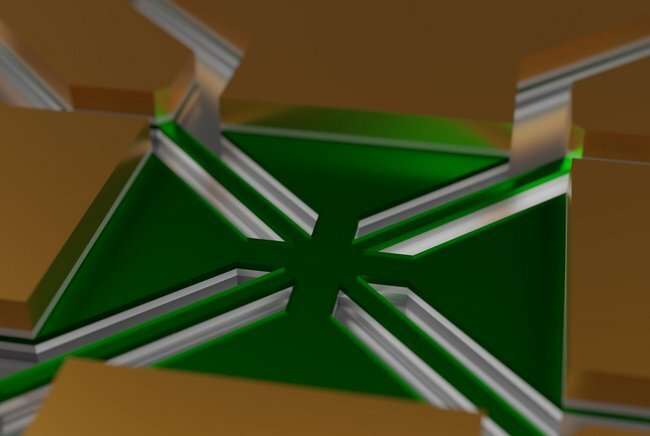NiO/CoO antiferromagnetic device. Credit: Casper Schippers
Society's increasing use of electronic devices motivates the search for new and better data storage techniques. Magnetic storage devices, such as hard disk drives, have been the mainstays for data storage over the past few decades. However, these devices, which use ferromagnetic bit orientation to store data, are fast approaching their physical limits. Replacing ferromagnets with antiferromagnets, the magnetic cousin of ferromagnets, can address this limitation, but controlling the magnetic orientation of antiferromagnetic bits is a challenge. For his Ph.D. research, Casper Schippers studied several aspects of different antiferromagnetic materials to ascertain their suitability for future data storage applications.
In magnetic storage devices, data is stored using the orientation of the magnetic moments of a magnetic bit, which are often made of ferromagnets. By changing the orientation of the magnetic moments from up to down, it's possible to store either a "0" or a "1." Ferromagnets, however, exhibit a net magnetization, meaning that they generate a magnetic stray field which can affect adjacent bits.
To solve this issue, one can replace the ferromagnets with antiferromagnets. In contrast to ferromagnets, antiferromagnets are materials that exhibit zero net magnetization, despite having a magnetic structure at the atomic level like ferromagnets. This means that they have a magnetic orientation in which data can be stored (just like in a ferromagnet), but they generate no magnetic stray fields and are extremely insensitive to magnetic fields.
For potential data storage applications, that means that two adjacent antiferromagnetic bits have no way of affecting each other via stray fields, which is the main issue limiting the density in ferromagnetic data storage.
However, this insensitivity and absence of stray fields also makes manipulating and inspecting the magnetic order of antiferromagnets challenging. However, in 2018, researchers reported for the first time that it is possible to intentionally change the direction of antiferromagnetic bits using electrical currents. This is a major step towards using antiferromagnets in data storage applications.
Anisotropy independence
Having the means to control antiferromagnetic bits is just the start, as researchers also need to know more about how different properties of antiferromagnets affect their capacity to be used for data storage.
For his Ph.D. research, Casper Schippers studied several different aspects of antiferromagnets and how these affect their potential use in devices. First, he investigated the anisotropy, or the preferred orientation of the magnetic moments, in antiferromagnetic cobalt oxide (CoO) (which is a material commonly used in antiferromagnets) using high magnetic fields, where he observed that the anisotropy does depend on the orientation and strength of the magnetic field. This is in contrast to what has been assumed by researchers until now.
Electrical manipulation
Next, Schippers looked at the electrical manipulation of the antiferromagnetic materials CoO and nickel oxide (NiO). Experiments to explore the possibility of electrical manipulation are often plagued by non-magnetic parasitic effects that cannot be distinguished from the actual magnetic effects the experiments try to demonstrate. With this in mind, Schippers and his collaborators studied two techniques to disentangle the magnetic and the non-magnetic effects by changing the temperature and applying high magnetic fields.
Finally, Schippers also studied the antiferromagnetic, so-called Van der Waals material nickel phosphorus trisulfide (NiPS3). He showed that when the material is interfaced to an ordinary ferromagnet and a current is driven through the ferromagnet, it can exert unexpectedly efficient torques on the magnetization of the ferromagnet.
The work described in Schipper's thesis increases our fundamental understanding of antiferromagnets, and adds to the available tools for investigating and working with antiferromagnets. Schipper's research paves the way towards actively using antiferromagnets in data storage devices in the future.
More information: Alternating moments: Or towards applications using antiferromagnetic spintronics. research.tue.nl/nl/publication … sing-antiferromagnet
Provided by Eindhoven University of Technology
























